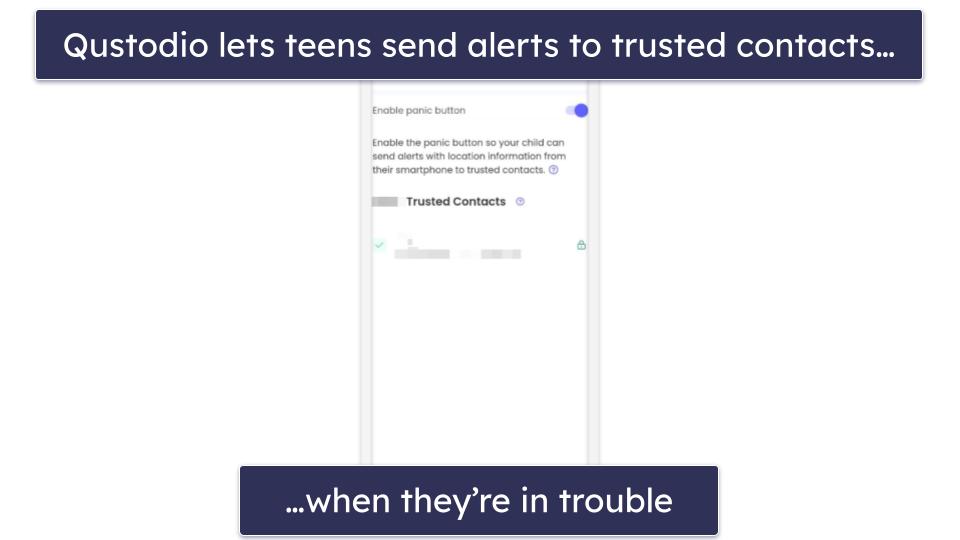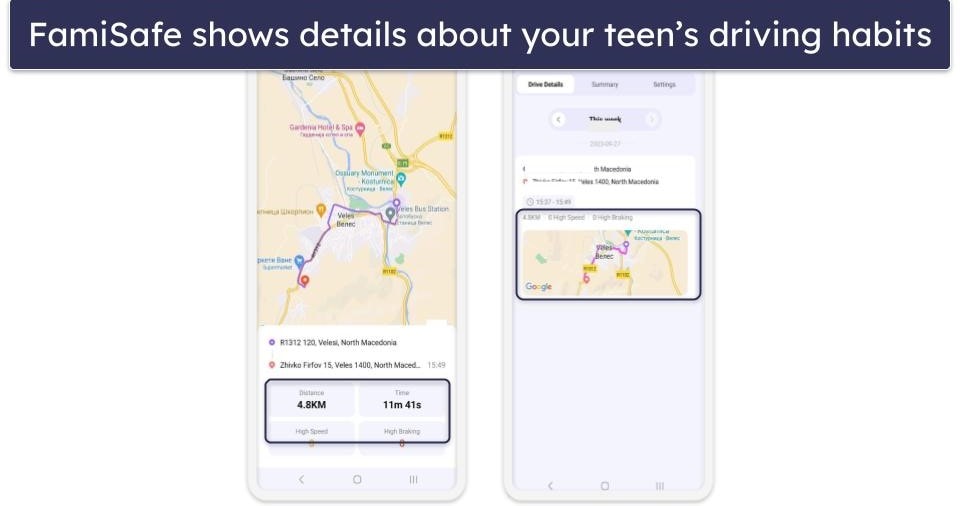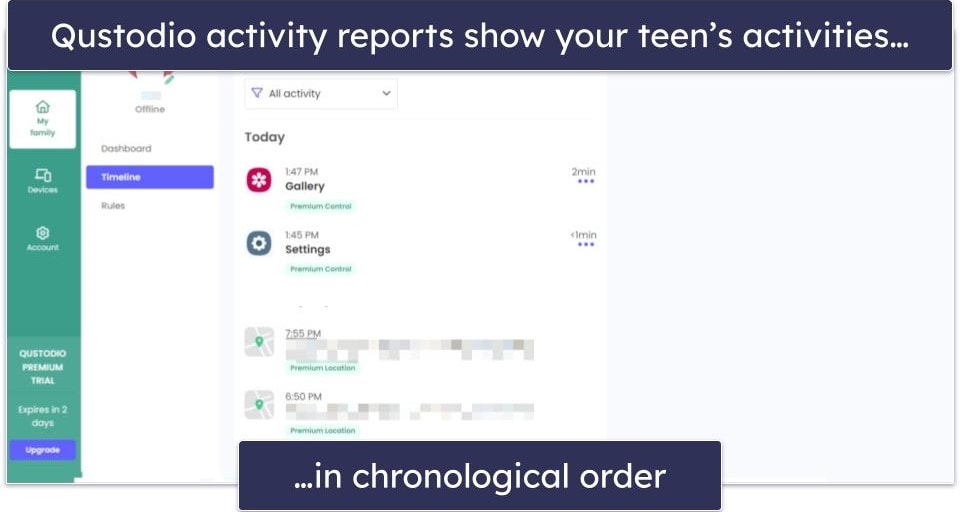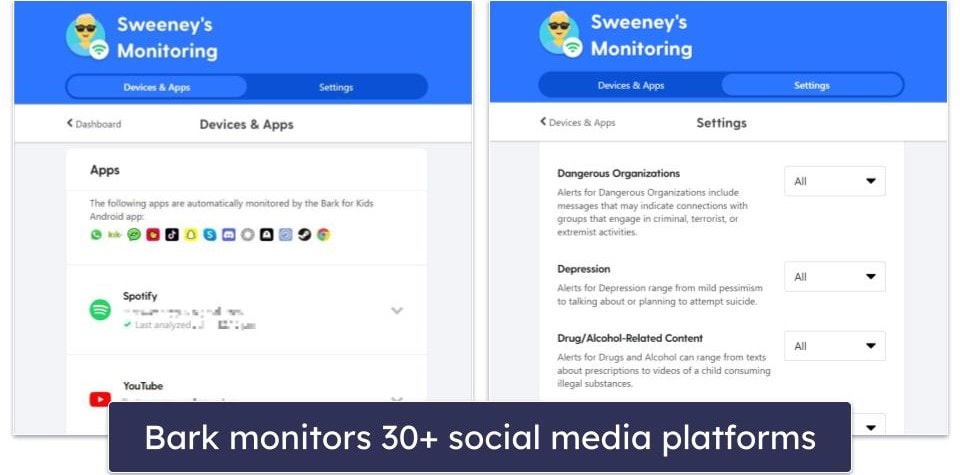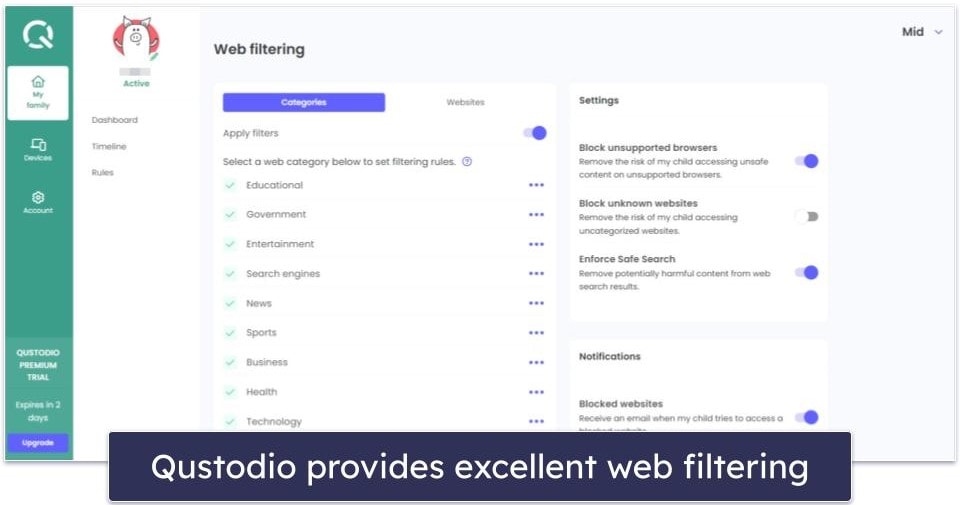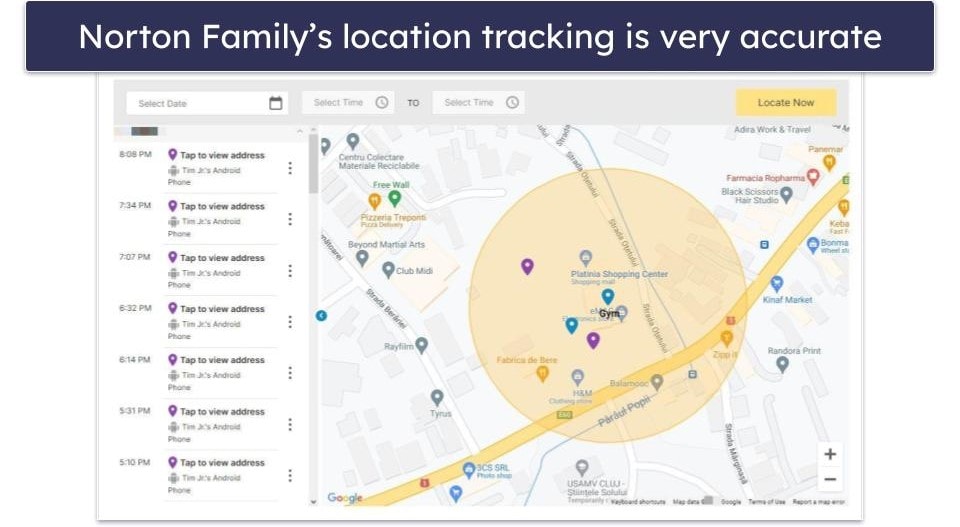
Marlene Baiton
Updated on: January 10, 2024
The internet is a double-edged sword for teens. It gives them limitless opportunities for learning and socializing, but it also exposes them to risks like doxxing, catfishing, and cyberbullying. As a parent and cybersecurity expert, I’ve crafted this essential guide to arm you with the knowledge you need to protect your teen from the dangers of the digital world.
I’ll primarily focus on providing you with actionable advice for safeguarding your teenagers online. This includes setting up foolproof privacy measures to deal with cyberbullying. However, teens, there’s something here for you, too. Reading alongside your parents, you’ll learn how to independently secure your digital life, see strategies for maintaining your privacy on social media, and more.
A good parental control app like Qustodio is essential for protecting teens online. It has real-time location tracking, web and app filtering, a dedicated YouTube monitoring feature, and even a panic button. These features help prevent issues like cyberbullying and exposure to inappropriate content, and offer insights into your teen’s digital behavior. It’s a powerful tool that seamlessly complements the guidelines we’ll be diving into.
11 Internet Safety Tips for Teens
1. Install a Good Quality Parental Control App
The cornerstone of online safety for teens is a good parental control app. These apps can serve as a protective shield and an educational tool for your teen. Let’s look at features particularly beneficial for teenagers:
- Social Media Monitoring: The best parental control apps offer comprehensive social media monitoring. This feature lets you track your teen’s activities across platforms like Instagram, Facebook, and Twitter. It also provides insights into the time spent on these platforms and the type of interactions teens are having.
- Emergency Alerts: Some apps (like Qustodio) come with a panic button, which your teen can activate if they’re in trouble. This sends an immediate alert to predefined contacts, providing an extra layer of security. Note that they don’t alert authorities.
- YouTube Monitoring: I really like Qustodio’s YouTube monitoring feature. It enables parents to see what videos their teens are watching and what terms they search for on YouTube. You can also set time limits or block the YouTube app and site completely.
- Time Management: Norton Family is great for overseeing your teen’s screen time. It allows parents to set daily limits in 30-minute increments, or you can opt for the app’s pre-set limitations. A unique aspect is the “School Time” feature, which enables you to restrict your teen’s internet usage up to 8 hours a day, granting access only to educational or reference sites during these hours. Additionally, if your teen needs extra time, they can directly request it through the app.
- Driving Monitoring: FamiSafe offers a unique driving monitoring feature for families with teen drivers. It provides detailed reports on driving habits, such as speed, distance covered, and instances of hard braking. This information is invaluable for teaching new drivers about road safety and responsible driving.
Remember, choosing the right parental control app is more than just a security measure — it’s a mutual agreement between you and your teen to navigate the complexities of the online world safely. If your teen isn’t happy about it, apps like Bark offer a balanced approach, focusing on monitoring while respecting your teen’s privacy and autonomy. Open communication is key. Discuss why you’re implementing these tools and how they can help protect against specific dangers like cyberbullying and inappropriate content.
2. Enable Privacy Settings
Never underestimate the importance of privacy settings, particularly on social media platforms where personal information can be easily exposed. Going through privacy settings on platforms like Facebook, Instagram, and Twitter with your teen is a must-do activity. These settings control who can see their posts, who can send them friend requests, and even who can look them up using their email address or phone number.
Empowering your teen to understand and set their own privacy controls is crucial for online safety. For instance, they can set their Instagram account to ‘Private,’ so only approved followers can see their posts. On Facebook, they can limit friend requests to ‘Friends of Friends’ and control who can see their content. Guide them through these settings, emphasizing their importance for personal security.
It’s also essential for you to periodically review these settings together. This approach not only ensures they’re making responsible choices, but also creates a secure environment for them online. The goal is to balance their independence and your peace of mind.
3. Foster Open Communication
Open and honest communication is crucial when it comes to internet safety. In a world where teens are navigating friendships, relationships, and their own identities online, talking openly about these experiences is vital.
Start by setting a regular time to talk with your teen about what they’re doing online, much like you would ask about their day at school. This is where detailed activity reports can be useful — consider going through them together as part of these routine conversations. Create a non-judgmental environment where your teen feels comfortable sharing their online experiences. Reiterate that they can always come to you with any concerns, be it a questionable individual they’ve encountered online or issues with cyberbullying.
This open communication allows you as a parent to identify and address potential risks before they escalate, and it also educates your teen about what to look out for online. It empowers them to recognize red flags and to approach you when something doesn’t feel right, creating a safety net of trust and proactive behavior.
4. Teach Critical Thinking Skills for Online Interactions
One of the best shields against online risks is teaching teens to think critically about what they encounter online. This goes beyond not clicking on suspicious links or avoiding strangers — it’s about evaluating the information and intentions behind any interactions they have online. That said, you can also install reputable antivirus software to add an extra layer of protection against malware and phishing attacks — automatically scanning for threats that might not be immediately obvious.
If your teen receives a friend request from a stranger, encourage them to question the stranger’s motives. Is this person who they say they are? Could this be a fake profile? The same goes for information consumption. With the prevalence of fake news and misinformation, teaching your teen to question sources and fact-check can be invaluable. Encourage them to verify information from multiple trusted sources before believing or sharing it.
This skill is not just for immediate safety but also for long-term digital literacy. These critical thinking skills will remain essential as they grow older and have to deal with more complex issues like online banking or even professional networking.
5. Educate About Cyberbullying and Its Consequences
Understanding the gravity of cyberbullying is essential for both avoiding it and knowing how to react if it occurs. Many teens may not fully grasp the real-world impact of their online actions or may not recognize cyberbullying when they see it. That’s why it’s crucial to educate them about what constitutes online harassment and the serious consequences it can have for both the victim and the perpetrator. Parental control apps like Norton Family often provide helpful resources and articles on how to deal with cyberbullying effectively.
Explain that cyberbullying isn’t just limited to mean comments — it can involve spreading rumors, posting embarrassing photos, or even impersonating someone else online. Make teens aware that such actions can lead to severe emotional distress for the victim and can have legal ramifications for those doing the bullying.
Equipping your teen with coping strategies is equally important if they ever find themselves on the receiving end of cyberbullying. Encourage them to speak up by confronting the bully if it’s safe to do so, or by reporting it to trusted adults and platform administrators. Remind them to document any instances of bullying by taking screenshots as evidence.
6. Monitor Social Media Use
Social media offers a space for teens to connect and express themselves, but it’s also filled with potential risks like cyberbullying and exposure to inappropriate content. Monitoring your teen’s social media doesn’t mean snooping — think of it as guidance. Periodically review their posts, comments, and friends list to spot any red flags. Discuss any concerns openly, teaching them about responsible online behavior.
Consider using Bark for focused social media monitoring. Unlike other apps that rely on keyword filtering, Bark employs advanced machine-learning algorithms to scrutinize over 30 social media platforms for various issues, such as bullying or signs of anxiety. This makes it a uniquely effective tool for detecting nuanced concerns that may otherwise go unnoticed.
7. Safeguard Personal Information
Teaching teens to protect their personal information is a non-negotiable rule for internet safety. Many teens don’t realize the risks involved in oversharing online, whether it’s their location, school details, or even passwords. Make it clear that certain information should never be shared on social media, forums, or online games.
Discuss the potential risks of oversharing, such as stalking or identity theft. Teach them the basics of secure online behavior, like avoiding clickbait links that request personal information or quizzes that seem fun but are actually phishing attempts. Remember, good antivirus software can help protect against malicious sites and phishing attempts, adding an extra layer of security.
8. Use Safe Search Features
Enabling Safe Search on search engines and YouTube can act as an additional barrier against inappropriate content. Even with the best intentions, a simple search can sometimes lead to explicit or harmful content. This is where Safe Search settings come in handy. They filter out potentially inappropriate material, making the online experience significantly safer for your teen.
Guide your teen through the process of turning on these features in commonly used platforms like Google, Bing, and YouTube. Ensure they understand that while SafeSearch is helpful, it’s not foolproof and shouldn’t replace good judgment.
Some parental control apps, such as Qustodio, can enforce Safe Search settings across various platforms to provide a more comprehensive web filtering experience, giving you both control and peace of mind.
9. Discuss the Dangers of Catfishing and Meeting Online Friends in Person
It’s an exciting time when teens meet online friends in person, but not everyone is who they say they are. When an individual creates a fake identity to deceive others into meeting them, this is often called ‘catfishing’. The allure of a new friendship can sometimes make teens lower their guard. Stress the importance of never meeting up with an online friend without discussing it with you first.
Catfishing can lead to dangerous situations where your teen may be lured into meeting someone who has malicious intent. Explain the risks involved, ranging from being stood up to more severe dangers like abduction or assault. If your teen insists that the friend is genuine, offer to accompany them to a public meeting spot for the first encounter. Better yet, recommend a video call before in-person meetings to verify the individual’s identity.
Parental control apps can play a role here, too. Features like location tracking and geofencing allow you to monitor your teen’s whereabouts and ensure they only meet in pre-designated safe zones. Some apps (like Norton Family) even offer the option to request your teen’s location anytime. This can be particularly useful if they’re not home when expected.
10. Encourage Safe Online Shopping
Understanding secure e-commerce practices is essential as online shopping gains popularity among teens. Many teens are drawn to the convenience of online shopping but may not be aware of the potential risks involved, such as scams or identity theft.
Teach your teen to recognize secure websites by looking for “https” in the URL or a padlock icon in the address bar. Explain the importance of using strong, unique passwords for each online account, and warn against saving credit card information on websites.
For an added layer of security, consider using Bitdefender Safepay. It’s a protected browser designed to keep online transactions, like banking and shopping, private and secure, making it a valuable tool in safeguarding personal information.
11. Use Secure and Unique Passwords for Each Account
One of the simplest ways to enhance online safety is by using strong, unique passwords for each online account. Password reuse is a common mistake among teens, making it easier for hackers to gain access to multiple accounts once they crack one password. Teach your teen to create complex passwords that combine letters, numbers, and symbols.
Encourage the use of a reputable password manager, which can generate and store complex passwords and provide auditing tools to recognize weak ones. This eliminates the need to remember every password and adds an extra layer of security.
Emphasize the need for selective and secure password sharing. If absolutely necessary, use secure methods like NordPass’s password-sharing feature to share passwords with friends. This allows access without revealing the actual password. However, never share passwords for critical accounts like email or banking. Casual sharing can lead to unauthorized access and data leaks, so instill the importance of treating passwords as confidential information.
Internet Safety Advice to Give Your Teenager
Good parental control apps and monitoring tools are essential, but it’s equally important for teenagers to take responsibility for their own online safety. Equip them with the knowledge and skills to navigate the digital world securely. Here are some fundamental pointers you can share with your teenager:
- Be a critical thinker: Don’t believe everything you read or see online. Some people and websites have ulterior motives. Approach everything with a questioning mindset.
- Use antivirus software: Having a reliable antivirus program on your devices is like having a security guard for your digital life. It scans for malware, blocks suspicious links, and even checks your Wi-Fi network for vulnerabilities. Make sure it’s always updated for the best protection.
- Guard your info: Your personal information is valuable. Never recklessly share passwords, your location, or other sensitive details online. Even those fun quizzes could be gathering your data.
- Think before you post: Whatever you put online could be there forever, affecting things like college applications or job searches. Ensure what you post online is something you’re okay with the world seeing.
- Be cautious with online friendships: Making new friends is cool, but be cautious when those friendships start online. Before meeting an online friend, try a video call first to ensure the online friend is who they say they are. Ensure you can see them clearly, that they’re not calling from a dark room or sitting out of the camera frame. Always meet in public places and let someone know where you’ll be.
- Handle cyberbullying correctly: If you’re being cyberbullied or see it happening, know how to block the offender and report the abuse. You’re not alone, and you don’t have to put up with it.
- Shop safely online: Before buying anything, ensure the site is secure. Look for “https” in the URL, and always log out of your account when you’re done.
- Check app permissions: Before downloading an app, see what it’s asking to access. If a game wants to know your location or access your messages, that’s sketchy.
- Strong passwords are a must: Always use strong and unique passwords for your accounts. If you find it hard to remember them all, consider using a password manager.
- Keep software updated: It’s not just about the newest features — many updates include important security patches.
- Use two-factor authentication: This is an extra step, but it adds another layer of security to your accounts. It’s worth the minor hassle for the major security boost.
Remember, tools like Qustodio and Norton Family are great for extra layers of security, but the best defense is being informed and cautious. So arm yourself with this knowledge and stay safe out there!
What Are the Dangers of the Internet for Teenagers?
The internet offers many opportunities for learning, socializing, and entertainment, but the risks are real and serious, especially for teenagers. Here are some primary dangers:
- Cyberbullying: One of the most prevalent risks, cyberbullying can have severe emotional and psychological impacts. Platforms like Instagram and Twitter are often breeding grounds for targeted harassment and bullying.
- Online predators: Predators often use sites like Omegle or chat rooms to groom teenagers for exploitative or harmful situations, masking their true intentions behind fake profiles and avatars.
- Identity theft: Teens often overshare personal information on platforms like Facebook, making them prime targets for identity theft. Stolen data can be used for illegal activities or sold on the dark web.
- Exposure to inappropriate content: From violent videos to explicit material, the internet is full of content that is not age-appropriate for teenagers. Even seemingly innocent searches can lead to disturbing results.
- Scams and phishing attacks: Teens may not recognize the signs of a scam and could fall for phishing emails or fraudulent schemes, potentially leading to financial loss or compromised personal information.
- Addiction and mental health: Excessive use of the internet, particularly social media and online gaming, can lead to addiction, anxiety, and depression.
- Sexting and revenge porn: Apps like Snapchat can be misused for sharing explicit content, which can then be weaponized as revenge porn or used for blackmail.
- False information and radicalization: The internet is a breeding ground for misinformation and extremist content, which can negatively influence a teen’s beliefs and actions.
- Meeting strangers: The thrill of meeting an online friend in real life can quickly turn dangerous if that person isn’t who they claimed to be.
- Unsafe online shopping: Without proper guidance, teens might make purchases from unsecured websites, risking financial information being stolen.
Being aware of these risks is the first step in safeguarding against them. Parental control apps like Qustodio should be the first line of defense, but education and open communication are also key to a safer online experience for teens.
Frequently Asked Questions
How can I talk to my teen about internet safety without invading their privacy?
Open, non-judgmental communication is key. It’s important to approach the topic as a dialogue rather than a lecture. Start by sharing your concerns in a way that makes it clear you’re coming from a place of caring, not controlling. Encourage your teen to express their own thoughts and concerns. Let them know that the primary goal is to ensure their safety, not to invade their personal space. Also, be upfront about any monitoring tools or parental control apps you use so they don’t feel spied upon.
Is it safe for my teen to shop online?
Yes, but they should follow secure e-commerce practices. Online shopping is convenient and offers more variety than local stores, but it comes with risks. Guide your teen toward reputable websites that use secure payment methods. The URL should start with “https,” indicating a secure connection. Teach them about the importance of strong passwords and two-factor authentication.
What are some signs that my teen might be experiencing cyberbullying?
Changes in behavior, mood, or online habits can be indicators of cyberbullying. Your teen might start withdrawing from family and friends or show signs of anxiety and depression. You might also notice a decline in their academic performance or a reluctance to attend school. It’s crucial to keep the lines of communication open so your teen feels comfortable discussing these issues with you. Cyberbullying is a serious concern that can have long-term emotional and psychological impacts; it should be addressed promptly and sensitively.
How can I monitor my teen’s social media without being intrusive?
Use parental control apps that offer non-intrusive social media monitoring features. Some specialized software solutions like Bark focus on looking for concerning behaviors or content rather than giving you full access to your teen’s accounts. These tools can alert you if they detect signs of cyberbullying, inappropriate content, or interactions with potentially dangerous strangers. This allows you to step in when necessary without continuously invading your teen’s privacy.




